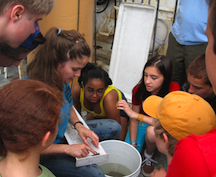
"Get out there and explore!" as Miss Frizzle from the Magic School Bus says, and what better way than to investigate the mighty Hudson River, its denizens and the ecology of this 315-mile-long river that originates in the Adirondacks and runs down to the Battery of NYC. It also "runs up," which is why the Native Americans referred to it as Muhheakan, meaning river that flows two ways. Visit The River Project and find out about this and other fun facts of the NY Harbor.
The River Project, a nonprofit organization, is a marine science field station dedicated to the protection and restoration of the Hudson River ecosystem through scientific research and hands-on environmental education for all ages and grade levels. Some examples of their research include:
- Fish Ecology: Committed to improving the ecological environment for fishes, The River Project has been fish monitoring for 23 years. After moving to Pier 40, 23 fish traps have been established along the north side of Pier 40 on historic steamship Lilac to monitor the fish composition and relative abundance in the river and keep the fish data updated on a regular basis.
- Fish Aggregating Device: Installed at Pier 42 pile field at Morton Street, the FAD aims to establish a more interactive relationship between the underwater animals and city dwellers, and enhance the experience of living in Hudson River Park community.
- Water Quality Testing: Soon to launch the Citizen's Water Quality Monitoring Program. This program will provide a timely report to keep our community well-informed about sewage levels in the Hudson River, which indicates if the water is safe for boating or swimming
- Oyster Gardening and Monitoring: in collaboration with NY/NJ Baykeeper and the New York Harbor School, seeks to increase stewardship among residents of the New York-New Jersey Harbor Estuary by working with volunteers from schools and community organizations in New York City.
Programs at The River Project introduce schoolchildren, teachers, families and the community to the biodiversity of the Hudson River Estuary through a guided tour of the estuary, ongoing wildlife monitoring activities, lectures and a visit to its aquarium tanks. The theme is local ecology of the region: past, present and future. See and touch estuarine animals, and investigate plant and animal survival strategies for the Hudson River communities. For a full immersion into science, animal husbandry, and aquarium mechanics, internships for high school and college students are available during the summer and fall, with limited opportunities in the winter and spring.
Marine biology interns will learn about animal identification, water chemistry, and the ecology of an estuary. Interns will assist educators on field trips and occasionally have an opportunity to run a topic station on his/her own. School program fees vary and are adjusted on a sliding scale. With a strong commitment to community education and partnerships, no group has ever been turned down due to inability to pay. Please call for specific information.
The River Project has open hours during the week where anyone can come in for a free tour. Please visit the events calendar on their website.
Cathy Drew, Executive Director, founded the River Project in 1986. The dedicated staff includes Chris Anderson, Head of Education; Yu Goa, Communications Coordinator, Outreach and Fundraising; Kathryn Eddins, Educator; and Nina Zain, Head of Interns.
Photo: Students learn how to measure fish for scientific research.
Join teachers, artists, scientists and marine enthusiasts for an adventurous professional development plunge into ocean studies on Saturday June 9 at the SUNY Maritime College under the Throgs Neck Bridge in the Bronx.
Featured keynote speaker Jesse Ausubel, Senior Research Associate at Rockefeller University, and Director of the Census of Marine Life (CoML) will amaze you with unusual discoveries of sea life, such as the "hairy" Yeti crab, a new species discovered by international scientists exploring the deep sea vents in the Antarctic. Named after the fabled Yeti abominable snowman of the Himalayas, this blind crab may use the hairy fibers to trap bacteria as food, or possibly use the bacteria in the fibers to filter out toxic minerals that are released from the vents. Discoveries beget discoveries.
You think you have challenges taking attendance in your classroom; see what happens when you try to take attendance in the Oceans' registrar. This monumental task involves 2,700 scientists from 80 nations, making 30 million observations. Research scientist Ausubel, one of the esteemed blue-ribbon honored awardees, stated "that the project has identified more than 200,000 different forms of marine species, from plankton to sharks, and perhaps there are a million more forms of complex life yet to be discovered".
Dr. Peter Rona, Professor of Marine Geology and Geophysics at the Institute of Marine and Coastal Sciences at Rutgers University, will take you on a tour of the Hudson Canyon, just miles off the NY-NJ Harbor. Imagine a canyon almost as big as the Grand Canyon, in our own underwater backyard, and navigating through it with a submersible! This ice-age formation occurred about 10,000 years ago when sea level was 400 feet lower than the current level. The canyon is one of the largest submarine canyons, extending out 400 miles seaward across the continental shelf, with walls nearly a mile deep. A unique habitat and winter destination for several species of fish such as flounder, sea bass, longfin hake, and red crabs, it is also a home for deep-sea corals and sponges. Who knows what else may lurk in over 10,500 feet of water when the Hudson River was once a dumpsite for city sewer sludge, reaching and settling into this little studied enormous canyon.
Join Richard Ellis, renowned marine artist, author, and recipient of the Explorers Club Communications Medal in 2012, in an intimate art & science workshop, along with other presenters such as Dr. Artie Kopelman, discussing marine mammals of New York; Pew Institute Educator Jamie Pollack, reviewing the future of iconic fishes, and sharks in our oceans; Bill Monahan, providing a history of oceanography; Becky Schneider will do a workshop on teaching about NY Harbor; and Dr. John Tanacredi will feature horseshoe crab ecology and local population studies.
The day is filled with lectures, workshops, and fieldtrips on kayaks, or a visit to the campus marine museum, or dockside water quality studies with NYSMEA field educators Tom Green and Lou Siegel.
Full registration ($105) includes all lectures, workshops, fieldtrips, breakfast, lunch and a lobster dinner. Visit exhibitors, and participate in an evening auction to bid on marine fossils, lab kits, books, and marine artifacts and biofacts. Make an investment in your teaching tool kit, and enjoy professional and friendly, fun networking.
College students are encouraged to attend with a discounted student registration rate. Professional development credit is available.
Why write about a great event that already happened and disappoint so many of our devout readers? Get Marinated Now and join us on June 9!
Please visit the NYSMEA (NYS Marine Education Association) website for conference information and registration at www.NYSMEA.org
Sea you there.
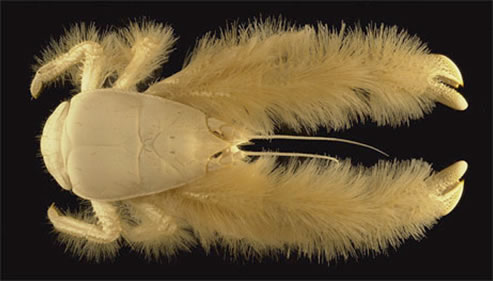
The discovery of the Yeti Crab resulted in the creation of a new family of crabs, although it's a distant relative of the more common hermit crab.
The Hudson River Foundation (HRF) is dedicated to scientific research and education that expands the history, culture, and ecology of the mighty, majestic river that runs through 314 miles of New York State.
The HRF offers free monthly seminars to the public to instill both a respect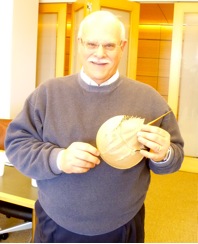 and understanding of this complex waterway. This month's guest speaker, Dr. John Tanacredi, Chairman of the Earth and Marine Science Department at Dowling College, and Director of the Center for Estuarine, Environmental and Coastal Oceans Monitoring (C.E.E.C.O.M) gave us a peek into the adaptations of this ancient creature and current perils that threaten its survival. and understanding of this complex waterway. This month's guest speaker, Dr. John Tanacredi, Chairman of the Earth and Marine Science Department at Dowling College, and Director of the Center for Estuarine, Environmental and Coastal Oceans Monitoring (C.E.E.C.O.M) gave us a peek into the adaptations of this ancient creature and current perils that threaten its survival.
Over 450 million years of evolution rendered the horseshoe crab a master of survival, including five mass animal extinctions. Equipped with a hard shell, compound eyes that form a mosaic image, and at least 12 simple eyes that are light sensors, the "crab" also has valuable blue blood that coagulates in the presence of toxins. Hence the hunt for this body fluid, which is used as a diagnostic tool for medical and pharmaceutical industries. The blue blood is able to detect spinal meningitis, hepatitis, toxins and other impurities. Dr. Rosen, a medical doctor among the audience of civic leaders, educators and scientists, provided personal testimony mandating by state law the application of horseshoe blood to verify pure conditions during kidney treatments. Historically, Native Americans have used horseshoe crabs as fertilizer, the tails were used as fishing spears, and the shells were used to bail water from canoes. Today, threats to horseshoe crabs include capture for bleeding (they are supposed to be released and returned after limited blood letting), habitat loss, pollution, wastewater discharge, commercial bottom draggers, and bait for eels, conchs, and whelks. There is also some pressure from human consumption, although there is almost nothing to eat on this animal, unlike other true crabs.
Horseshoe crabs have a wide distribution on the Atlantic coast, from Maine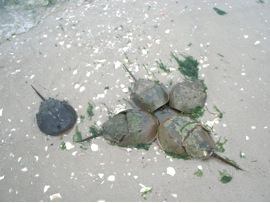 to Mexico, and are absent on the west coast in the U.S. Delaware Bay is the hot spot where the population density is the highest. Plum Beach, along the Belt Parkway in Brooklyn, is the major breeding ground in New York. During the months of May and June, precisely synchronized with the new and full moon at high tides, thousands of horseshoe crabs form orgies on the beach to breed. This is also the time for millions of coastal birds to feast on the crabs' little green eggs that abound just beneath the sand. For curriculum material, fact sheets, and scheduled teachers' workshops up and down the Atlantic seaboard, google "green eggs and sand". to Mexico, and are absent on the west coast in the U.S. Delaware Bay is the hot spot where the population density is the highest. Plum Beach, along the Belt Parkway in Brooklyn, is the major breeding ground in New York. During the months of May and June, precisely synchronized with the new and full moon at high tides, thousands of horseshoe crabs form orgies on the beach to breed. This is also the time for millions of coastal birds to feast on the crabs' little green eggs that abound just beneath the sand. For curriculum material, fact sheets, and scheduled teachers' workshops up and down the Atlantic seaboard, google "green eggs and sand".
Although accurate data is lacking as to the number of horseshoe crabs, possibly 4-10 million exist along the Atlantic coast. Dr. Tanacredi has focused his population inventories from the tip of Brooklyn to the tip of Montauk, indicating that populations have had peeks and falls, but have experienced a net 10% decline over a ten-year period. They are not on the endangered species list, but perhaps they warrant a species of concern status. New York State does not have any ban on the taking of horseshoe crabs as yet, and regulations are relaxed, except in protected areas, such as the Jamaica Bay Wildlife Sanctuary. Should you see a horseshoe crab in trouble, please "flip it" carefully turning it right side up. It just may save your life someday.
For information about the Hudson River Foundation and the schedule of seminars, research projects, and grants, please visit www.hudsonriver.org. The HRF is under the superb supervision of the Executive Director Mr. Clay Hiles.
Images of long-lost shipwrecks, whale sharks, first-century marble columns, diving into blue holes in the Bahamas, and attempting to save the world's iconic fishes --- just an ordinary day for extraordinary explorers visiting New York City.
Incorporated in 1905, and dedicated to the advancement of field research and scientific exploration, the Explorer's Club hosted "Sea Stories" on Nov. 19th, at their NYC based headquarters, 46 East 70th Street.
Explorers, divers, scientists, filmmakers, writers, and yes, the general public was invited to hear about scientific adventures during a 10-hour immersion of presentations, conversations, and food and drink. "It's like the pages of National Geographic coming to life", said one guest, Dan Lieb, a NJ historical diver.
The following is a brief synopsis of each explorer's presentation:
Steve McPhee, a commercial dive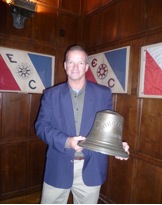 r, marine surveyor, and explorer from the Bahamas, revealed the story of the three-masted barque, the Dorothea, last sighted adrift in 1913 off of Bermuda. This ghost ship and her crew remained a mystery, until McPhee began to trace her origins from Hamburg, Germany, after uncovering her 55-pound bell almost 100 years later. McPhee was able to research the crew, its cargo and the threats to her demise at sea. r, marine surveyor, and explorer from the Bahamas, revealed the story of the three-masted barque, the Dorothea, last sighted adrift in 1913 off of Bermuda. This ghost ship and her crew remained a mystery, until McPhee began to trace her origins from Hamburg, Germany, after uncovering her 55-pound bell almost 100 years later. McPhee was able to research the crew, its cargo and the threats to her demise at sea.
Dr. Rachel Graham, from the Wildlife Conservation Society and Director of the Gulf and Caribbean Sharks and Rays Program, focused on the migration patterns of whales sharks and rays. Whale sharks are filter feeders, eating copious amounts of copepods, fish eggs, and small fish and invertebrates using a sucking and pump action behavior with the mouth wide open. Delicate gill rakers function like a sieve, capturing planktonic (free-floating) prey. The whale sharks are tagged with pop-up archival transmitters that record and send data on water depth, temperature, and light level to satellites. As Dr. Graham says, "the animals send us an email of where it's been". The whale sharks' deep dives during the day to over 60 feet may be a form of thermoregulation, or receiving navigational cues (stronger magnetic force the deeper you go) or finding sources of food. Major threats to whale sharks include people finning them as a status symbol, strikes with ships, and predation by great white sharks.
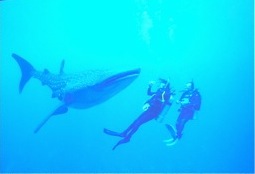 Mark Gordon, President and Chief Operating Officer for Odyssey Marine Exploration, manages a 25-30 million dollar a year operation engaged in shipwreck, resource and archeological recovery. Gordon discussed the following seven keys for a successful exploration, which applies to achieving many goals in most disciplines: Mark Gordon, President and Chief Operating Officer for Odyssey Marine Exploration, manages a 25-30 million dollar a year operation engaged in shipwreck, resource and archeological recovery. Gordon discussed the following seven keys for a successful exploration, which applies to achieving many goals in most disciplines:
1) Clean vision and plan
2) Build your network
3) Recruit top talent with meaningful input
4) Equip your team with the best tools and techniques
5) Expect and prepare for adversity
6) Balance risk and return
7) Be passionate about what you do
In conclusion, a good strategy helps to achieve success in your adventures.
Dr. Debbie Carlson, Professor, Texas A & M University, is an underwater archaeologist specializing in ancient Mediterranean history and architecture. Carlson discovered bronze coins and marble cross sections of columns (drums) from a ship that sunk off of Turkey in the first century B.C. Following the transport and assembly of the marble drums to form a column, the carving and fluting of the marble was then done onsite, usually for a temple. Amphoras, large ceramic jugs that carried the valued commodities for transport, differ from one region to another, each with its own distinctive clay type and style. Dating the material is accomplished by using isotope carbon analysis of the stone, based on the rate of decay of the carbon, which is found in the earth, in the air, and in the water.
Dr. Kenny Broad, Professor, University of Miami's Rosenstiel School of Marine and Atmosphere Science, has been featured on National Geographic and PBS for his exploration of the Blue Holes of Bermuda. Caves are one of the least explored underwater habitats, requiring unique gear, great skills, and taking great risks. Divers must squirm through nearly invisible crevices, with anoxic (lack of oxygen) rotten egg-like smelling sediments surrounding you. But the scenery is unbelievable and dreamlike. Similar to terrestrial caves, sea caves have stalactites (top) and stalagmites (bottom). These slowly growing pillar formations form when water dissolves the limestone bedrock. The growth rate may be from half an inch to 3.5 inches (1 to 9 cm) every 1,000 years! Broad uses the term "bioprospecting" to find new life forms that live in extreme habitats: maybe on a microbial mat, rich in hydrogen sulfide, and tainted pink, from a pigment inside the bacteria. A perfect place for fossilization, Broad found ancient turtles, crocodiles, owls, and human remains in these blue holes, along with discovering unfamiliar living forms of life without eyes, or pigments.
Dr. Kevin Weng, Oceanographer from the University of Hawaii, has been studying the migration of sharks and fish, and in particular, a boney fish called the Napoleon Wrasse. Adult great white sharks have long migrations, from California to Hawaii, while the juveniles stay closer to the coastline travelling between the U.S. and Mexico. The Napoleon Wrasse, a rare and beautiful slow-moving fish, has a small home range within ½ mile off of the Palmyra Atoll. This atoll is a pristine remote island near the Equator, just south of the Hawaiian Islands. The Palmyra Atoll was purchased by the Nature Conservancy and is now a U.S. Fish & Wildlife Refuge for scientific research. The Napoleon Wrasse feeds on the crown-of thorns sea star, which is a major predator to coral reefs. The decline of the Napoleon Wrasse will result in greater losses of coral reefs, upsetting the predator-prey balance. Understanding the breeding and migration habits of endangered species will help to develop protective measures to ensure their survival.
Each time you see pictures of exotic places, maps of continents or ocean currents, read data points, or stories of adventure, think of all the work, personal sacrifice, courage and determination of both past and present explorers. Teachers... create an explorers day and have your students research and report to the class.
Visit the Explorer's Club website for information on special events and lectures that are open to the public. The Explorer's Club encourages and provides support for young budding scientists in high schools and colleges through the Youth Activities Fund. The Exploration Fund is designed for graduate students to assist in field research leading to advanced degrees. Visit these websites for more information on marine science and exploration.
www.shipwreck.net
www.wildlifetracking.org
www.whaleshark.org
www.Explorers.org
www.nysmea.org
Get out there and explore!
Come onboard the American Princess, docked at Fort Tilden at Riis Landing in the Rockaways, for a science-at-sea adventure right in our own harbor.
The beautiful and comfortable 95-foot Coast Guard-certified vessel will be
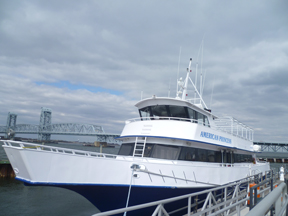
your passage to explore the marine life of our coastlines, our lifelines. See harbor seals that have made New York their winter rookery on the two man-made islands just south of the Verrazano Bridge, Swinburne and Hoffman Islands. Harbor seals "love" N.Y. Why do they stay? N.Y. offers a milder winter and abundant fish. Students can participate in CITIZEN SCIENCE seal counts with Paul Sieswerda, former curator at both the New England and New York Aquariums. You can observe seal behaviors such as the banana position, which is what they look like when they haul out on the rocks. These behaviors, and the biology and adaptations of these marine mammals, called Pinnipeds, will be discussed along with a PowerPoint presentation by Paul, who is the naturalist onboard the winter, spring and summer schedules. Dr. Merryl Kafka is the naturalist onboard for the spring and summer schedule, alternating with Paul.
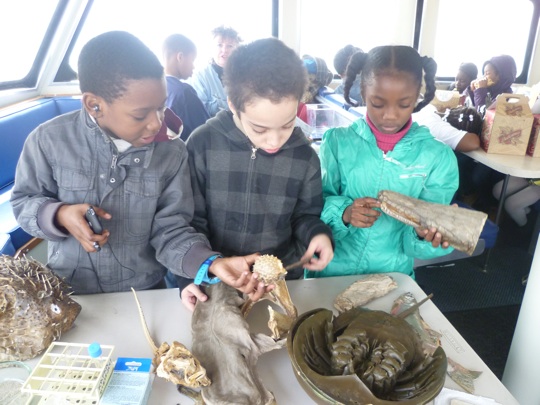
The summer begins the whale migrations, as our Atlantic Ocean is the corridor for finback and humpback whales traveling north to Stellwagon Bank, a fertile feeding ground off the coast of Provincetown, Mass. We typically see hundreds of bottlenose dolphins, whose most northern range is now extending to New Jersey and New York. Pods of these graceful swimmers can be seen just off the Atlantic Highlands, at the mouth of the lower New York Bight.
During the summer, educational excursions include PowerPoint presentations on the biology of whales and dolphins, biofact and live plant/animal handling of collected specimens, viewing of plankton and selected water testing. Specific class programs and marine science themes can be arranged with prior notification.
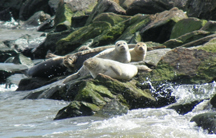
The seal-watching schedule for the winter begins the first week of February until mid-April, and the dolphin/whale watching begins in June.
For more information, please visit American Princess Cruises for fees and seasonal schedule, or special excursions. The main office is (718) 474 - 0555. Special student group rates may vary from $10 - 15 per person, depending on the number of people for a three-hour educational excursion. Total capacity is 150 students.
In 1524 navigator Giovanni Verrazano explored New York Harbor. Isn't it about time you do!
Teachers from the New York State Marine Education Association (NYSMEA) packed their knapsacks, not for school, but rather a unique educational outing to explore the stone quarries of Ithaca, New York, in the hunt for trilobites and a visit to the Museum of the Earth.
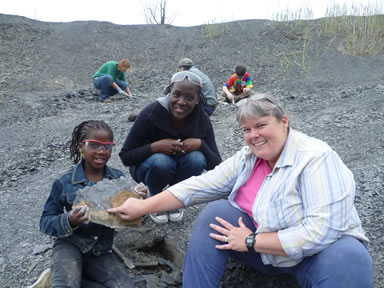 It's hard to imagine that for most of the Earth's history, New York State and in fact, most of Northern America, was covered by a warm shallow marine seaway, which left behind a rich fossil record. The sediments of these early seas were later thrust up by plate tectonic events, forming both the mountains of New York and the eastern coast of North America. It's hard to imagine that for most of the Earth's history, New York State and in fact, most of Northern America, was covered by a warm shallow marine seaway, which left behind a rich fossil record. The sediments of these early seas were later thrust up by plate tectonic events, forming both the mountains of New York and the eastern coast of North America.
Trilobites are extinct invertebrates whose distant living relative today is the horseshoe crab. They resemble pill bugs or insects in that they have segmented bodies and compound eyes. Trilobites seemed to be among the most dominant and widespread group of marine invertebrates during the middle of the Devonian Period, about 360 million years ago. However, trilobites expanded the entire Paleozoic Era, going back to the Cambrian Period, over 500 million years ago.
Trilobites usually inhabited shallow waters, digging themselves into the mud or swimming (although thought to be poor swimmers) close to the bottom. They probably fed on small organisms or dead organic material as scavengers. The back of the trilobite body has a hard carapace that was divided longitudinally into three lobes (hence the name tri-lobe).
With some basic tools in hand, such as hammers, chisels, and safety goggles, we went to work pounding what was once layers of ancient mud that turned into shale over hundreds of millions of years. Although we were determined (and guaranteed) to find trilobites, several other invertebrate fossil specimens were uncovered, including clams, worms, snails, and their traces left as footprint in the mud: wavy trackways, trails, burrows, and borings.

As preparation to our fossil hunt, NYSMEA was invited to the New York Explorer's Club in Manhattan for a presentation on trilobites by Dr. Yumiko Iwasaki, an invertebrate paleontologist from the American Museum of Natural History. We learned about the tools and techniques of fossil collecting in the field and prep work in the lab, in addition to the evolution and morphology of a group of trilobites called phacopids. This group has a unique formation; a big, bulging overhanging stomach in between the compound eyes. I guess it did get enough to eat!
It was wonderful to see one young student and her siblings and parents from St. Ann's School in Brooklyn Heights, join her teacher, Sarah Richards, on this expedition. Our field trips (and membership) are not just for teachers: we like to encourage the total immersion of learning for the entire family.
For more information, visit our website: www.NYSMEA.org for updates on special events, field trips, conferences, professional developments and job opportunities, and internships. Become a member and get marinated!
Want to spice up your science lessons? Want to enrich students with engaging science content and process skills in the classroom, on the beach, and in the lab? If yes, then enroll in SeaCamp's Teachers' workshop in tropical marine ecology and literally get immersed in marine science education.
 |
| Mangrove habitats surround the Newfound Harbor Marine Institute, SeaCamp. |
Each year, for four days in February during the President's weekend, The Newfound Harbor Marine Institute in Big Pine Key, offers teachers and college students an intensive and fun-filled workshop. The curriculum is rich, the teaching styles are diversified, and the approach is a total-body learning experience.
Program topics included Florida's geology, coral reef and turtle grass ecology, invertebrate zoology, and phycology, which is the study of sea plants. During the day you'll feel like an adventurous 12 year-old camper: bunk beds, family-style dining, and scheduled activities such as boating, snorkeling, lectures and labs.
Snorkeling over colorful reef fishes, mangroves, and sponge beds will reveal the variety of unique habitats. Coral reefs, like underwater cities, have day and night shifts that help reduce competition for resources. Enjoy kayaking over shallow turtle grasses and calcareous alga that house a multitude of invertebrates such as shame face crabs, shrimp, and brittle sea stars.
The evening agenda consisted of identifying sea plants, plankton, and invertebrates, as well as attending a selection of interactive lectures on bioluminescence, nocturnal adaptations, animal behavior, shark biology, and squid dissections. The college students were particularly ambitious: evening extracurricular activities included conducting a "population inventory" of the local bar, and "sampling" the pH of margaritas! When asked what were the benefits of attending this workshop as science education interns, they quickly referred to the valuable hands-on experiences, seeing different teaching styles in a non-traditional setting, and expanding their perceptions of careers in education.
Middle school teachers were inspired to integrate ocean studies into both the physical and life sciences, and to develop lab activities with smaller clusters of students.
All teaching levels...pre-service, in-service, or just marine science enthusiasts... benefited from this exploratory workshop. The registration fee is $300 for room, board, instruction and field trips. Participants receive a certificate for 21 hours of service credit.
For younger learners, SeaCamp offers programs for elementary to high school students during the summer and intersession.#
For more information, contact Chuck Brand, Director of Marketing, SeaCamp Association, Inc., Newfound Harbor Marine Institute, 1300 Big Pine Key, FL 33043, Ph: Toll free: 1-877-732-2267, Email: info@nhmi.org, Website:www.nhmi.org
You may have heard of the booze cruises in Sheepshead Bay, but now get ready for the teacher's version of the curriculum cruise, an adventurous way to "marinate" your kids. Your students will be immersed in the rich resources and history of New York Harbor once aboard the famous yellow Water Taxi. The National Park Service and the NY Harbor Conservancy joined forces to produce this floating classroom featuring National Park Rangers equipped with biofacts such as horseshoe crabs and diamondback turtle shells for participants to handle.
 Listen carefully: A pre-recorded narration by the city's most prestigious scientists, ecologists, authors, and educators (I had the honor of participating) will guide you past our city of islands -- Ellis, Liberty, Hoffman and Swinburne (just south of the Verrazano Bridge) -- Coney Island, and into Jamaica Bay Wildlife Refuge, a federally protected area comprising over 9,000 acres. Listen carefully: A pre-recorded narration by the city's most prestigious scientists, ecologists, authors, and educators (I had the honor of participating) will guide you past our city of islands -- Ellis, Liberty, Hoffman and Swinburne (just south of the Verrazano Bridge) -- Coney Island, and into Jamaica Bay Wildlife Refuge, a federally protected area comprising over 9,000 acres.
Geologist Sidney Horenstein, from the American Museum of Natural History, will take you back millions of years to vast continental glaciers and describe how the narrows was formed just a mere 13 thousand years ago; authors John Waldman and Mark Kurlansky, respectively, discuss the richness of the harbor, the turbulence of the tides and the stratification of the Hudson, as well as the depiction of the oyster, once the size of dinner plates, and its role in New York. One oyster can filter 50 gallons of water a day! NPS Ranger and avid birder David Taft will take you into the skies, searching for predatory Peregrine Falcons, perching upon our tallest bridges, stooping with speeds up to 200 miles per hour!
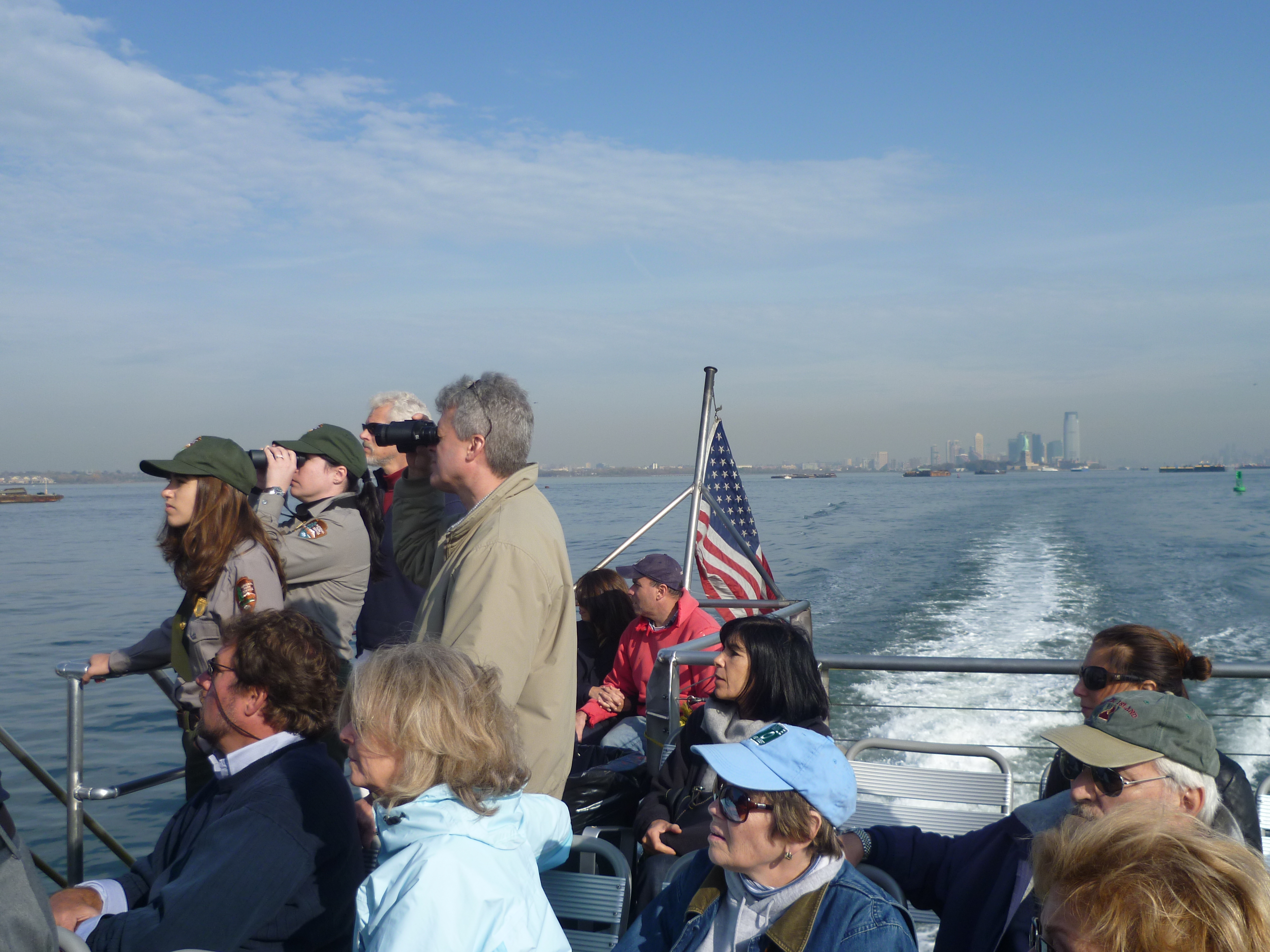 Marine science is so vital to our lives, and yet so underrepresented in our K-12 curriculum, both throughout the nation and in our city. Let's embrace the Ocean Literacy campaign for a smarter citizenship, infusing conservation ethics and local history, along with the sciences and the arts. "Naturally, New York" does it all! Marine science is so vital to our lives, and yet so underrepresented in our K-12 curriculum, both throughout the nation and in our city. Let's embrace the Ocean Literacy campaign for a smarter citizenship, infusing conservation ethics and local history, along with the sciences and the arts. "Naturally, New York" does it all!
In 1524 navigator Giovanni da Verrazano explored New York Harbor. Isn't it about time you did!
For more information on "Naturally, New York" Water Taxi spring trips, please contact:
Lindsay Burtchell
Development Manager
Harbor Conservancy
(212) 668-2776
(917) 817-1237 [Cell]
(212) 668-2896 [Fax]
lburtchell@nyharborparks.org
Resources for your classroom:
• John Waldman. 1999. Heartbeats in the Muck. The Lyons Press.
• Mark Kurlansky. 2006. The Big Oyster. Ballantine Books.
• Stephen Stanne, R.Panetta, and B. Forist. 1996. The Hudson: An Illustrated Guide to the Living River. Rutgers University Press.
Ocean Literacy information:
www.coexploration.org/oceanliteracy
www.education.noaa.gov
www.nysmea.org (NYS Marine Education Association)
|
|
|












